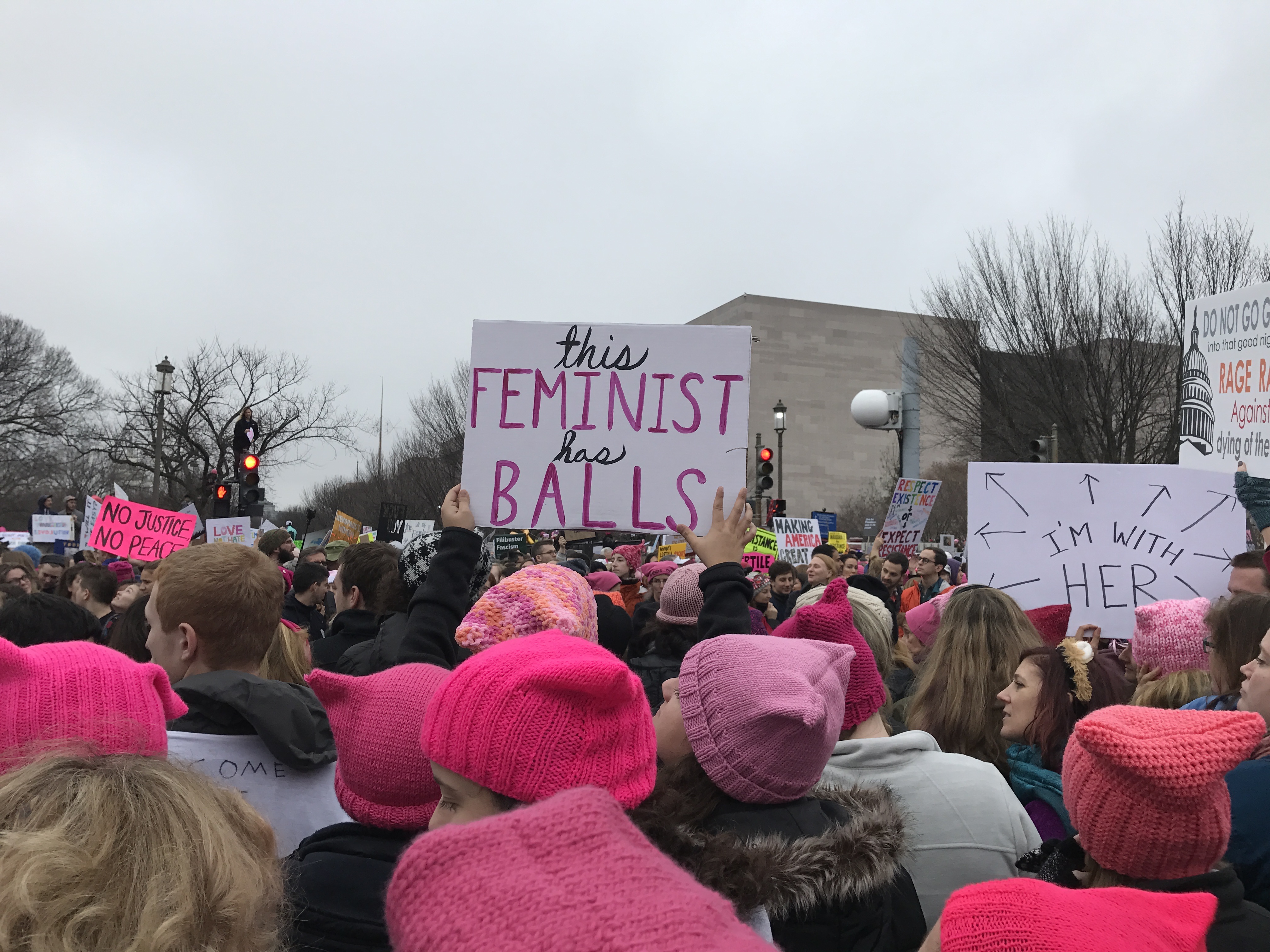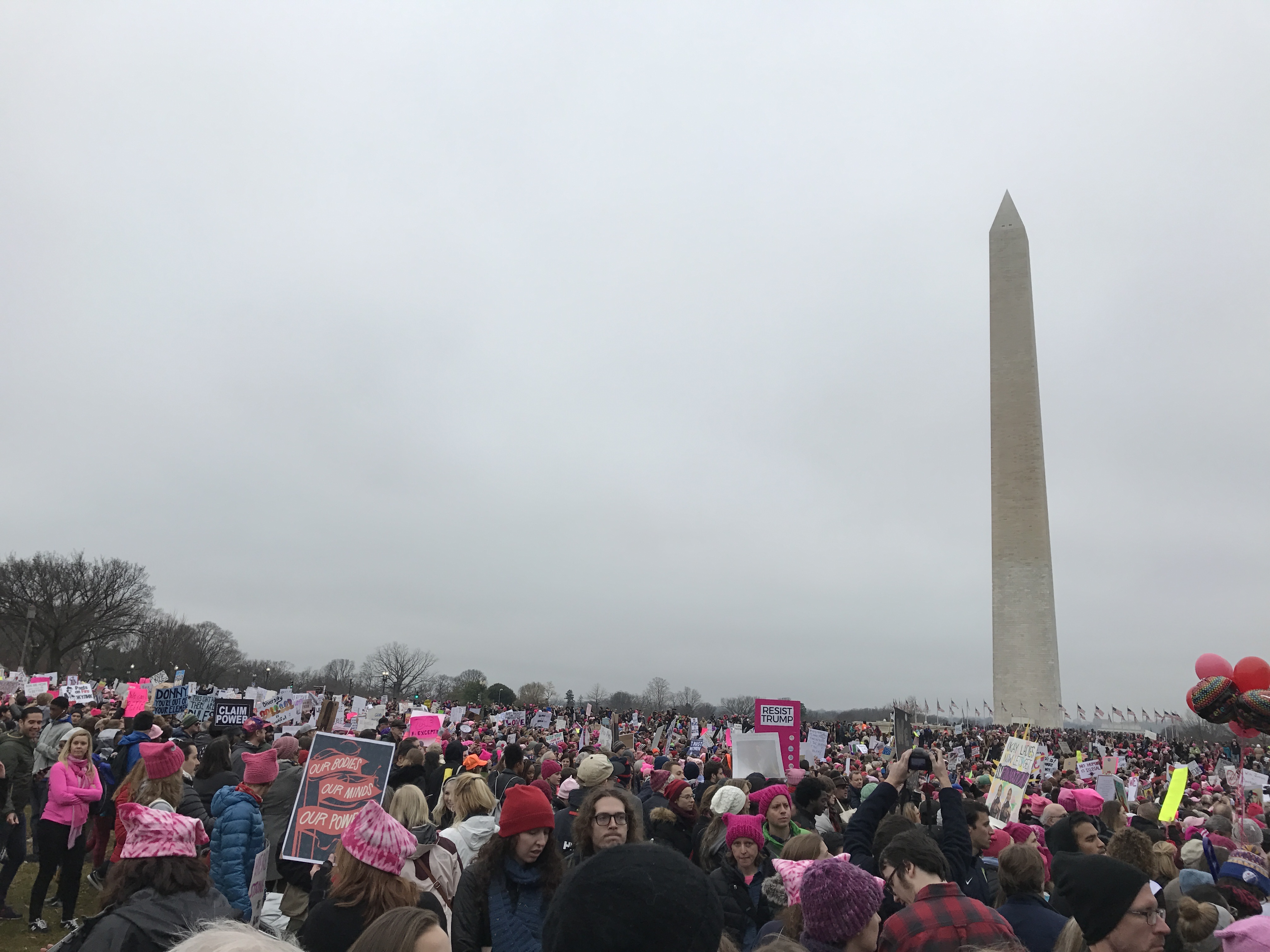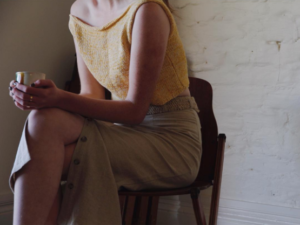
On January 21, 2017, nearly 500,000 Americans took to the streets of Washington D.C. marching in vast crowds from the Lincoln Memorial to the White House. These marchers were a byproduct of the presidential election of Donald Trump. Although the movement began with the Women’s March on Washington, a domino effect occurred in which women from all across the world went out to march on Saturday, sending an irrefutable global statement to the new Trump administration.
With only a month and a half to plan the march, the founders took a very democratic and non-hierarchical system of organization, placing inclusivity at the forefront of their mission. Their efforts seemed to have paid off in a substantial way; the Women’s March was the largest mass mobilization in U.S. history. The core values of the March were to “show our strength, power, and courage, and demonstrate our disapproval of the new president and his values in a peaceful march,” stated the organization in a November interview with Women in the World. The platform of the March emphasizes inclusivity for all identities including race, gender, age, ability and members of LGBTQ+ communities.
The March joins a long history of marches in which people came together to speak out about pressing issues. The organizers of the Women’s March on Washington took inspiration from a few historical marches in particular. Starting from as early as 1913 women’s rights protests such as the Woman Suffrage Parade, the Jeanette Rankin Brigade in 1968, the Women’s Strike for Equality of 1970, and the Million Mom March of 2000 have been a recurring theme in American politics. These marches helped to foster some of the goals of the Women’s March on Washington, as they were also largely organized by women with no prior experience as activists. By taking inspiration from movements dating all the way back to the early 20th century, the organizers of the Women’s March acknowledged and emphasized the continuous struggle that women face in the pursuit of equality. Although the Women’s March had its own objectives and values, it stems from a long lineage of marches that created the space for people to unify with the common goal of overcoming the inequalities facing modern women.
Notes from the San Francisco March
by Liv Jenks ‘19
On the morning of the 21st there had been a pro-life, anti-abortion march that gathered at San Francisco’s City Hall.
Within a matter of hours the mood dramatically shifted, as 100,000 marchers gathered at City Hall to celebrate the pro-women movement and protest Trump’s treatment and policies pertaining to women’s rights. The marchers were clad in pink pussyhats, t-shirts with phrases like “the future is female,” and a variety of other feminist paraphernalia. The masses of women were joined by people from all across the LGBTQ+ spectrum, as well as people from a range of ethnic backgrounds. They came out to make their voices heard on women’s rights as well as immigration, climate change, and a myriad of other topics that have aroused concern since Trump’s election.
I was there with my mom and another mother-daughter duo. We arrived at Civic Center, eager to participate in support of civil rights and justice. It was a rainy, dreary day; it seemed as though the skies too were crying in the aftermath of Donald Trump’s inauguration. Regardless of the weather, marchers were out, and spirits were high. In every direction I saw a sea of pink and signs that read, “Ikea has better cabinets,” “How many women does it take to crush a Cheeto?” “Pussy Grabs Back,” “A woman’s place is in the House and the Senate,” and many others. The signs took serious topics and made them witty while still conveying powerful, urgent messages. My personal favorite humorous jab was “We Shall Overcomb.”
While we were waiting for the march to begin, I asked a few people why they were marching. A young Ethiopian woman answered, “I’m gravely disappointed in the result of the election, and I’m ready to see progress.” Her boyfriend, originally from Nigeria, added, “I’m frightened by the message Trump made during the election and right now. But staying at home and being frustrated isn’t enough, so going out and seeing how many people are also frustrated is the right thing to do.”
I also asked a woman who brought her three children and husband, and she said she was there, “for my children’s future, for women’s right to choose, for climate protection, and because I think women lost their voices in this election.”
I spoke to a young female teacher who came up from Menlo Park to march with her parents and her boyfriend. She said she didn’t want to come initially because of the rain and the big crowds, but she realized that with the president and the world right now, she just needed to be there, and “stop complaining.” She added that, “I respect everyone’s opinions, but I need mine to be respected too. I’m terrified to have kids and try to raise them in this world, to try and teach them the difference between kindness and evil. I’m a teacher and I want my students to have more opportunities than I had when I was growing up. So that’s why I’m here.”
When it came time for us to march, we walked along either side of Market Street so trolleys carrying the people incapable of walking could pass through. I was surrounded by people of all ages. There was a group of older women in front of me, who walked in a line with linked arms. They laughed and talked about the times they marched with Gloria Steinem, back in the “good days.” And then behind me were two young girls, maybe five or six, with their parents, trying to push through the crowd and continually jumping up and down trying to read the signs people hoisted in the air. It was a medley of the past and the future, together in solidarity.
I marched because this is the America that I’m inheriting. I marched so my kids won’t have to fight the fight that so many women before me have had to. I marched because I want to help break the glass ceiling.
Notes from the Washington D.C. March
by Pilar McDonald ‘19
I looked around; the marchers’ pink pussy hats colored my view in every direction. The marchers wore shirts announcing feminist ideals. The crowd of 500,000 was chaotic, with people chanting frantically. I, on the other hand, was serene. People, especially women, chanted at the top of their lungs, “my body, my choice,” and their male counterparts chanted, “her body, her choice.” It was these individual voices, who really cared, coming together so that millions of people could hear them.

photo by Pilar McDoanld
As I was chanting and jumping around to make myself heard, I was proud to be who I was, something I don’t always feel. A smile crept across my face as I looked over the diversity crowd.
I spoke to a man named Leonard, who said,“I’m from Delaware, and I’m a Republican. I think Donald Trump is a disaster. I served in the military, and the Constitution that I swore to defend should protect my friends, relatives, and mentors who are gay, lesbian, and transgender who can’t be here; these are the people I’m marching for. So I am here to make sure that Trump knows we are watching him. We want to put the President on notice, we want him to know that he has no room to make a misstep.”
“My name is Kadeja, and I’m from D.C.. I came out to show support. With everything that is happening, I don’t support Trump at all. I feel like there is power in numbers and bringing people together. I believe that you can affect real change with that. I hope that everyone can see that there’s power in numbers and that people will start coming together to organize and strategize to find what the next possible steps are. This is the start of something else. I want the young kids here today to understand that their voices matter, more than anything, that they have the rights to vocalize their concerns.”
And every other person who fell under those 2.9 million people marching globally; I was marching for them, and they were marching for me. The feeling was overwhelming. With all the hate that I had been experiencing for the past few weeks, I felt so loved. There was love everywhere, in all forms. It was called the Women’s March on Washington, but this fight was just as much a march of love for everyone.
I took an Uber back to my cousin’s house. The driver was an Ethiopian woman, who asked me where I was from. “California?! Wow, you’re very far from home.” She proceeded to ask me why I was here, curious as to whether I was a Californian coming for the inauguration, or if I was marching. I began to tell her some of my story, but I found myself timid to share it all as I didn’t know which “side” she was on—this fear of mine further proving the harsh divide in our country, I didn’t speak freely as I was afraid of triggering her in some way.
I surprised myself by being timid. I’ve grown up in a household where sharing and displaying my political values is encouraged and promoted. My “Hope” and “Nasty Woman” shirts put my love for Obama and Clinton on display.
I reevaluated what I was doing and shook myself out of it. “I marched because I believe that women deserve to be treated equally with men. I believe that we should get to make choices about our bodies and our lives for ourselves—just as men have been doing for years.” I surprised myself, yet again, by this blurt out.
She nodded, not saying anything else for the remainder of the car ride. I thanked her as I stepped out, and she waved, “It was great to hear you say that,” she shouted after me.
Notes from the Oakland March
by Betty Marcon
Betty Marcon ‘79, mother to Loic Marcon ‘17, was out and about among the 60,000 people at the Oakland Women’s March. She spoke to an older lesbian couple who had both protested the Vietnam war in college, “We’ve gone out for different political campaigns, and we’ve always been on the active side. We’re pro-choice, and we have four sons between us. We want their reproductive futures to be like our’s were, not more restricted. I hope that what young people get from this is that we can have one president, and this man is unfortunately our president. But we need to let the world know what we think about him; our voices are powerful.”

photo courtesy of Betty Marcon
She next spoke to a man dressed in drag as a nun. When asked what inspired him to come to the march today he said “[I] wanted to support women. I wanted to support a nation that is equal, positive, accepting, and just. I have done a lot of activism in my life. I am actually a member of the Sisters of Perpetual Indulgence. So we do a lot of work and activism helping disenfranchised communities. Hopefully, people take away from this that a lot of people are threatened right now, but that we can help defend each other from those threats.”
People of different backgrounds came together to defend their rights on January 21st. Trump’s campaign and many of his recent policy changes have threatened many people, and as a result, many other mass marches and protests have already occurred. It appears as though this presidency could be one where it is necessary to use our voices and stand up for what we believe in, as our rights might frequently be questioned.






